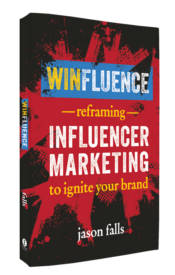In the early chapters of Winfluence – Reframing Influencer Marketing to Ignite Your Brand, I cite the Edelman Trust Barometer a few times. It is important in a published book to establish some factual basis for the argument you’re making, or the topic you’re covering. I pointed to a combination of studies, including Edeman’s annual survey of trust from various angles, to illuminate both consumer’s trust in influencers and lack of trust in traditional media. The numbers underline the idea that consumers trust influencers and their product recommendations. Hence, business owners and marketers need to read this book.
As Murphy and his law would have it, the 2021 version of the Edelman Trust Barometer was published a few weeks before my book, rendering the data there old. Fortunately, the Internet-based world of publishing allows me to thwart the inefficiencies of the ink-and-paper one and report a more updated argument.

If you review the report, and those of the last couple of years, you begin to see a media trust gap—trust in the traditional media falling and not necessarily being filled by other sources of information. Data from this year’s Trust Barometer indicates brands, and I would argue influencers, are primed to fill that void.
Media Trust Gap Widens as All Sources Drop
It’s not like 2020 was normal, really. So one might expect the global survey of trust to be a bit of a skewed mess. Across the board, all information sources lost measures of trust from the global audience of individuals surveyed. The traditional media (newspapers, magazines, television and radio) saw its collective trust score drop eight points, from 61 to 53. That means that almost half the general population no longer trusts them for information. It’s the lowest score for traditional media in the last 10 years of the survey.
Rubbing salt in the wound, 59 percent of respondents agree that journalists and reporters are purposely trying to mislead people by saying things they know to be false or exaggerated. The same percent of people agree that most news organizations are more concerned with supporting an ideology or political perspective than informing the public. And 61 percent—almost two-thirds of people—agree the media is not doing well at being objective and non partisan.
While it is perfectly valid to argue that these drops in trust are in media’s position as an information source for politics or news about government and things that matter. But if people lose trust in, say, the New York Times, and stop reading it. They stop reading the sections where your ads run or PR stories place, too. As trust in the media for “news” drops, so does consumption of media where your products or services might find an audience.
Consumers Trust People Like Them
This year’s published version of the Edelman Trust Barometer does not include marketing and advertising-specific trust measures that get specific to influencers or influencer marketing. However, there are some indications of where influential voices might lie. When the participants were asked about their trust levels for sources of information about a company, an academic expert and a person like yourself were both the higher ranking results. Fifty-seven percent of people trust the academician who talks about a company while 53 percent trust the person like themselves.
I would argue both the academic expert and the “people like me” are where influencers fall. Having an academic expert or two as friendly partners to speak on your behalf is classic influence marketing. And consumers follow those they identify with. Brands that partner with them for content and other executions are leveraging a person like you (or me) and more people trust those individuals than not.
Brands Can Fill the Media Trust Gap
For businesses and brands, the political and social unrest of 2020 that deteriorated the trust in government and media, seems to have put the opportunity in the hands of brands and business owners. The report indicates that companies and business are more trusted entities now than others and the events of 2020 created a new platform for social leadership. The vast majority of respondents (86%) said they expect CEOs to publicly speak out about societal challenges. And 68 percent said CEOs should step in when the government does not fix social problems.
It seems we have entered a new era when the public will now hold businesses and brands accountable for more than just cranking out widgets. This can greatly effect your content, social and influence marketing strategies. Aligning yourself with activism-leaning influencers, or at least those who take stands on certain issues, may be a smart play. My advice, however, is to only do this if you are 100% committed to that stance. Know that where many of your customers may join you in that cause, there will be some that won’t.
The Influence Trust Analysis
Those that consider influencers, online or not, to be members of the media might categorize consumer trust in them as falling. But it’s fairly clear to me that consumers do not consider the outstanding voices they find online to be news, journalists or even media. They consider them to be entertaining, engaging or even informative voices in the sea of social media. They aren’t reporters, editors, producers or journalists. That consumer trust in the media continues to drop only presents an environment of opportunity for influencers. They can, and often do, fill the void.
Until the Edelman Trust Barometer gets as granular as research like Jay Baer and Daniel Lemin’s Chatter Matters research, which I also cite in Winfluence, we won’t have a declarative insight here. But when I read the tea leaves presented, they say influencers are trusted more.
And that means they are ready to fill the media trust gap and continue to flourish.
Note: Photo by Joshua Hoehne on Unsplash

Pre-order Winfluence now!
Reserve your copy by ordering on Amazon, Barnes & Noble or direct from Entrepreneur Press and look for the book to be shipped when it publishes February 23! Learn why we’ve been backed into a corner to think influencer marketing means Instagram and YouTube and how reframing it to be “influence” marketing makes us smarter marketers.

